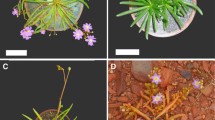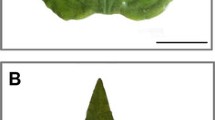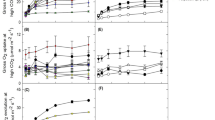Abstract
A comparison of carbon isotope discrimination characteristics, crassulacean acid metabolism (CAM) activity and gas exchange together with concurrent analysis of photosystem II (PSII) chlorophyll fluorescence was conducted on leaves of sympatric species of Clusia from the restinga of Barra de Maricá, Brazil. The carbon isotope discrimination (Δ) and leaf-sap titratable acidity for leaves collected in the field indicated that the carbon metabolism of one species, C. lanceolata, was predominantly C3-like, and a second, C. fluminensis, constitutive CAM. When well-watered under glasshouse conditions C. lanceolata displayed a gas exchange pattern expected of a C3 plant, where values of instantaneous discrimination (Δ) rose from 13.5% shortly after dawn to 21.9‰ at midday, suggesting that all CO2 uptake was mediated solely by ribulose 1,5-bisphosphate carboxylase (RUBISCO). C. fluminensis showed a gas exchange pattern which clearly exhibited all four phases of CAM. Δ values during phase II ranged from −0.4‰ at dawn to 5.9‰ some 3 h later, indicating that C4 carboxylation dominated CO2 uptake during the morning with an increasing contribution by RUBISCO, suggested by the 5‰ shift in Δ at this time. The dominance of phosphoenol-pyruvate carboxylase (PEPc) activity was also found during phase IV, and extended throughout the dark period (phase I) in C. fluminensis, such that values of Δ measured were negative (−5.0 to −0.4‰). This is the first time that negative Δ values have been reported, close to those predicted theoretically for PEPc activity. The day-time uptake of CO2 mediated by PEPc could lead to futile cycling through RUBISCO. In C. fluminensis organic acids were subjected to carbon turnover between PEPc and RUBISCO during phase II of CAM, serving perhaps to dissipate ATP and reductant at a time when excess photons are absorbed. Under low levels of photosynthetically active radiation (PAR) the two species displayed similar chlorophyll fluorescence characteristics, although for the CAM C. fluminensis a lower rate of decarboxylation of acids in the afternoon was reflected in changed quenching capacity. Under high PAR both species responded directly to changes in incident radiation, reflected by decreases in photon use efficiency (ΦPSII) and the intrinsic photochemical efficiency (F V/F M), together with high and reversible quenching of excess light by the means of radiationless or thermal dissipation (q N). Both species, with such markedly different carboxylation characteristics achieve similar rates of electron transport and maintain photosynthetic integrity. Under field conditions, however the severity of a prolonged dry season caused the CAM species to become deciduous, whereas the “C3-like” species remained healthy. This suggests that the widely expected advantages of CAM do not extend to tolerance of extreme environmental conditions, in contrast to the more C3-like of these sympatric species.
Similar content being viewed by others
References
Adams WW III, Terashima I, Brugnoli E, Demmig B (1988) Comparisons of photosynthesis and photoinhibition in the CAM vine Hoya australis and several C3 vines growing on the coast of eastern Australia. Plant Cell Environ 11:173–181
Adams WW III, Diaz M, Winter K (1989) Diurnal changes in photochemical efficiency, the reduction state of Q, radiationless energy dissipation, and non-photochemical fluorescence quenching in cacti exposed to natural sunlight in northern Venezuela. Oecologia 80:553–561
Arata H, Iwasaki I, Kusumi K, Nishimura M (1992) Thermodynamics of malate transport across the tonoplast of leaf cells of CAM plants. Plant Cell Physiol 33:873–880
Ball E, Hann J, Kluge M, Lee HSJ, Lüttge U, Orthen B, Popp M, Schmitt A, Ting IP (1991) Ecophysiological comportment of the tropical CAM-tree Clusia in the field. II. Modes of photosynthesis in trees and seedlings. New Phytol 117:483–491
Borland AM, Griffiths H (1996) Variations in the phases of CAM and regulation of carboxylation patterns determined by carbon-isotope discrimination techniques. In: Winter K, Smith AP, Smith JAC (eds) Crassulacean acid metabolism. biochemistry, ecophysiology and evolution Springer, Berlin Heidelberg New York, pp 230–246
Borland AM, Griffiths H, Maxwell C, Broadmeadow MSJ, Griffiths NM, Barnes JD (1992) On the ecophysiology of the Clusiaceae in Trinidad: Expression of CAM in Clusia minor L. during the transition from wet to dry season and characterisation of three endemic species. New Phytol 12:349–357
Borland AM, Griffiths H, Broadmeadow MSJ, Fordham MC, Maxwell C (1993) Short-term changes in carbon-isotope discrimination in the C3-CAM intermediate Clusia minor L. growing in Trinidad. Oecologia 95:444–453
Condon AG, Richards RA (1993) Exploiting genetic variation in transpiration efficiency in wheat: an agronomic view. In: Ehleringer JR, Hall AE, Farquhar GD (eds) Stable isotopes and plant-water relations. Academic Press, London, pp 435–450
Evans JR, Sharkey TD, Berry JA, Farquhar GD (1986) Isotope discrimination measured concurrently with gas exchange to investigate CO2 diffusion of leaves in higher plants. Aust J Plant Physiol 13:281–292
Farquhar GD, Ehleringer JR, Hubick KT (1989) Carbon isotope discrimination and photosynthesis. Annu Rev Plant Physiol. Plant Mol Biol 40:503–537
Fischer A, Kluge M (1984) Studies on carbon flow in crassulacean acid metabolism during the initial light period. Planta 160: 121–128
Franco AC, Ball E, Lüttge U (1990) Patterns of gas exchange and organic acid oscillations in tropical trees of the genus Clusia. Oecologia 85:108–114
Franco AC, Ball E, Lüttge U (1992) Differential effects of drought and light levels on accumulation of citric and malic acids during CAM in Clusia. Plant Cell Environ 15:821–829
Franco AC, Olives E, Ball E, Lüttge U, Haag-Kerwer A (1994) In situ studies of crassulacean acid metabolism in several sympatric species of tropical trees of the genus Clusia. New Phytol 126:203–211
Griffiths H (1992) Carbon isotope discrimination and the intergration of carbon assimilation pathways in terrestrial plants. Plant Cell Environ 15:1051–1062
Griffiths H, Broadmeadow MSJ, Borland AM, Hetherington CS (1990) Short-term changes in carbon-isotope discrimination identify transitions between C-3 and C-4 carboxylation during crassulacean acid metabolism. Planta 181:604–610
Holtum JAM, O'Leary MH, Osmond CB (1983) Effect of varying CO2 partial pressure on photosynthesis and on carbon isotope composition of carbon-4 of malate from the crassulacean acid metabolism plant Kalanchoë daigremontiana Hamet et Perr. Plant Physiol 71:602–609
Horton P, Ruban AV (1992) Regulation of photosystem II. Photosynth Res 34:375–385
Kliemchen A, Schomburg M, Galla HJ, Lüttge U, Kluge M (1993) Phenotypic changes in the fluidity of the tonoplast membrane of crassulacean acid metabolism plants in response to temperature and salinity stress. Planta 189:403–409
Kluge M, Kliemchen A, Galla HJ (1991) Temperature effects on crassulacean acid metabolism: EPR spectroscopic studies on the thermotropic phase behaviour of the tonoplast membranes of Kalanchoë daigremontiana. Bot Acta 104:355–360
Krause GH, Weis E (1991) Chlorophyll fluorescence and photosynthesis: the basics. Annu Rev Plant Physiol Mol Biol 42:313–349
Lüttge U, Beck F (1992) Endogenous rhythms and chaos in crassulacean acid metabolism. Planta 188:28–38
Lüttge U, Smith JAC (1984) Mechanism of passive malic-acid efflux from vacuoles of the CAM plant Kalanchoë daigremontiana. J Membrane Biol 81:149–158
Maxwell C, Griffiths H, Borland AM, Broadmeadow MSJ, McDavid CR (1992) Photoinhibitory responses of the epiphytic bromeliad Guzmania monostachia during the dry season in Trinidad maintain photochemical integrity under adverse conditions. Plant Cell Environ 15:37–48
Maxwell C, Griffiths H, Borland AM, Young AJ, Broadmeadow MSJ, Fordham MC (1995) Short term photosynthetic responses of the C3-CAM epiphyte Guzmania monostachia(L.) Rusby ex Mez var. monostachia to tropical seasonal transitions. Aust J Plant Physiol 22:771–781
Nimmo GA, Wilkins MB, Fewson CA, Nimmo HG (1987) Persistent circadian rhythms in the phosphorylation state of phosphoenolpyruvate carboxylase from Bryophyllum fedtschenkoi leaves and in its sensitivity to inhibition by malate. Planta 170:408–415
O'Leary MH, Osmond CB (1980) Diffusional contribution to carbon isotope fractionation during dark CO2 fixation in CAM plants. Plant Physiol 66:931–934
Osmond CB (1978) Crassulacean acid metabolism: a curiosity in context. Annu Rev Plant Physiol 29:379–414
Osmond CB, Allaway WG (1974) Pathways of CO2 fixation in the CAM plant Kalanchoë daigremontiana. I. Patterns of 14CO2 fixation in the light. Aust J Plant Physiol 1:503–511
Osmond CB, Holtum JAM, O'Leary MH, Roeske C, Wong OC, Summons RE, Avadhani PN (1988) Regulation of malic-acid metabolism in crassulacean acid metabolism plants in the dark and light: in-vivo evidence from 13C labelling patterns after 13CO2 fixation. Planta 175:184–192
Raven JA, Farquhar GD (1990) The influence of N metabolism and organic acid synthesis on the natural abundance of isotopes of carbon in plants. New Phytol 116:505–529
Reinert F (1995) On the Bromeliaceae of the restinga of Barra de Maricá in Brazil: environmental influences on the expression of crassulacean acid metabolism. PhD thesis, University of Newcastle upon Tyne
Ribas LDA (1992) Analise da estrura e composicao espeifica das comunidades vegetais de moitas de restinga em Maricá-Rio de Janeiro. MSc thesis, Universidade de Brasilia
Ritz D, Kluge M, Veith HJ (1986) Mass-spectrometric evidence for the double-carboxylation pathway of malate synthesis by crassulacean acid metabolism plants in light. Planta 167:284–291
Schreiber U, Schliwa U, Bilger W (1986) Continuous recording of photochemical and non-photochemical chlorophyll fluorescence quenching with a new type of modulation fluorometer. Photosynth Res 10:51–62
Smith JAC, Griffiths H, Lüttge U (1986) Comparative ecophysiology of CAM and C3 bromeliads. I. The ecophysiology of the Bromeliaceae in Trinidad. Plant Cell Environ 9:359–376
Ting IP, Hann J, Holbrook NM, Putz FE, Sternberg LDSL, Price D, Goldstein G (1987) Photosynthesis in hemiepiphytic species of Clusia and Ficus. Oecologia 74:339–346
Winter K, Lesch M (1992) Diurnal changes in chlorophyll a fluorescence and carotenoid composition in Opuntia ficus-indica, a CAM plant, and in three C3 species in Portugal during summer. Oecologia 91:505–510
Winter K, Zotz G, Baur B, Dietz KJ (1992) Light and dark carbon dioxide fixation in Clusia uvitana and the effects of plant water status and carbon dioxide availability. Oecologia 91:47–51
Zotz G, Winter K (1994) Annual carbon balance and nitrogen-use efficiency in tropical C-3 and CAM epiphytes. New Phytol 148:481–492
Author information
Authors and Affiliations
Rights and permissions
About this article
Cite this article
Roberts, A., Griffiths, H., Borland, A.M. et al. Is crassulacean acid metabolism activity in sympatric species of hemi-epiphytic stranglers such as Clusia related to carbon cycling as a photoprotective process?. Oecologia 106, 28–38 (1996). https://doi.org/10.1007/BF00334404
Received:
Accepted:
Issue Date:
DOI: https://doi.org/10.1007/BF00334404




